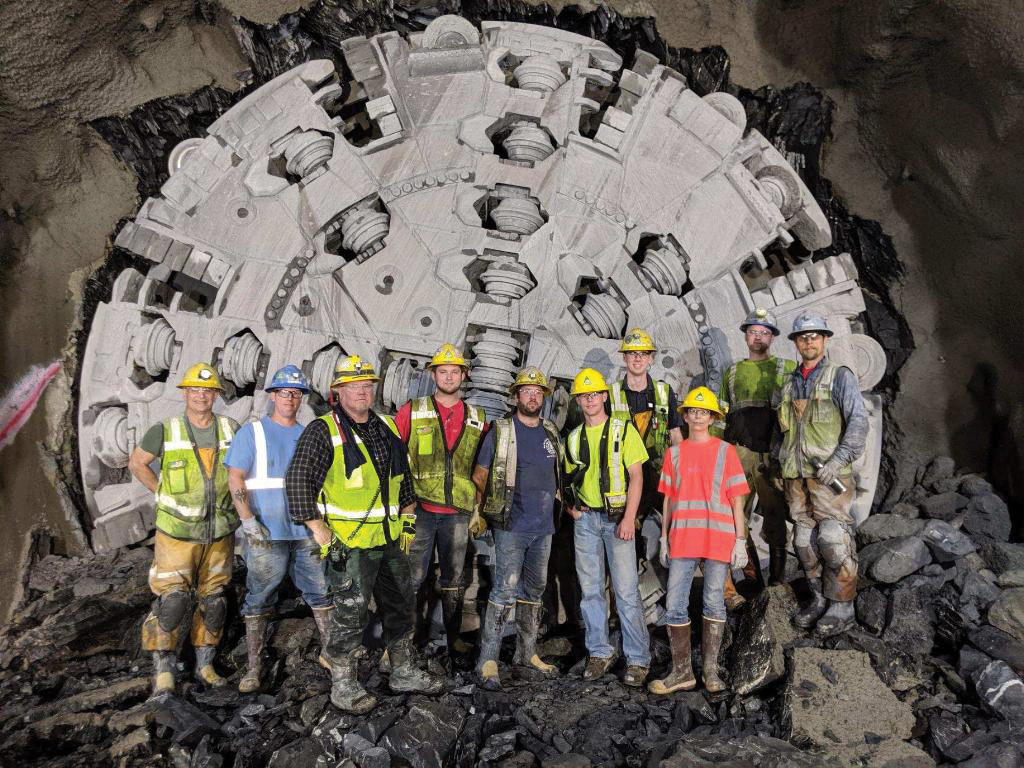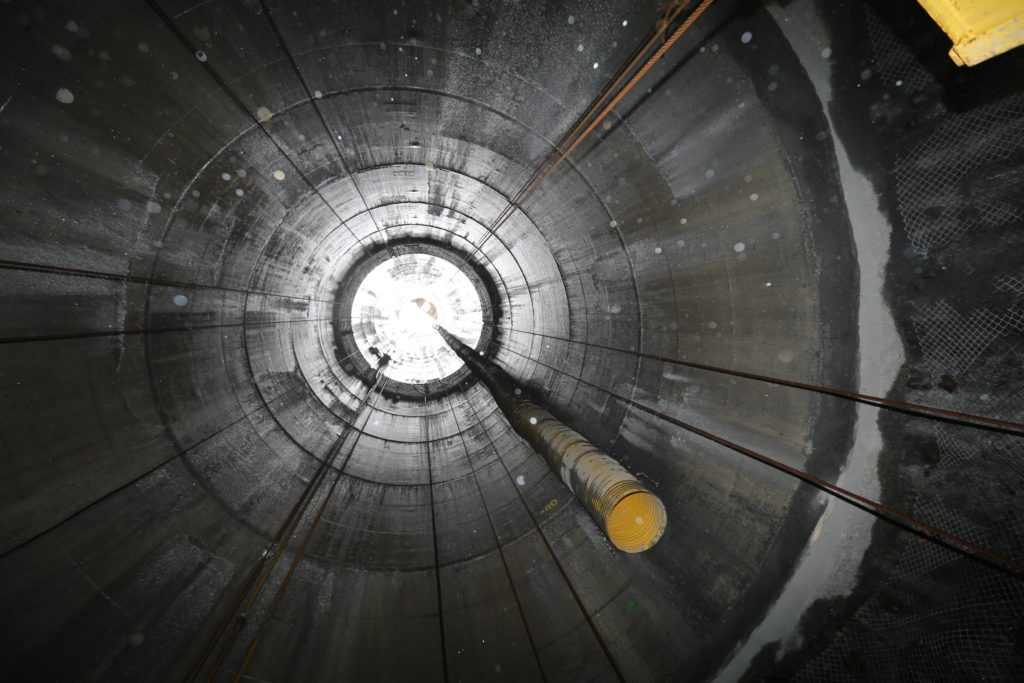罗宾斯博客
What it’s Like to Live at a Jobsite for a Year (or More): An Interview
Debbie Swival, Robbins Field Service Support, is no stranger to tunnel sites. Over her last 12 years at The Robbins Company she has worked on TBMs around the world, from the San Francisco Central Subway to the Moglicë Headrace Tunnel in a remote area of Albania to Turkey’s Bahce-Nurdag High Speed Railway and more. But her longest stay was in Newburgh, NY, USA for the Delaware Aqueduct Repair tunnel.
Swival remained on the jobsite from November 2017 until the TBM’s breakthrough in August 2019—a duration of 21 months. Her role in assisting the crew and troubleshooting issues was integral to the project’s success.
Boring Below the Hudson
The 6.8 m (22.3 ft) diameter Robbins Single Shield TBM for JV contractor Kiewit-Shea Constructors (KSC) bored a total of 3,794 m (12,448 ft) over 582 days with instantaneous penetration rates of 6 m (20 ft) per hour. The unique machine was designed to statically hold up to 20 bar pressure as it bored below the Hudson River to repair a section of the Delaware Aqueduct, the world’s longest continuous tunnel (137 km/85 mi long).
The New York City Department of Environmental Protection (NYCDEP), project owner, discovered that a section of the aqueduct below the Hudson River was leaking up to 75 million liters (20 million gallons) of water per day. On average the aqueduct—built in the 1930s and 1940s—supplies about 50 percent of the water consumed by 8.6 million residents of New York City and an additional 1 million residents in four counties north of the City. A swift repair of the tunnel section was essential.
The tunnel depth—ranging from nearly 270 m (900 ft) deep where the TBM was launched in Newburgh, New York to over 180 m (600 ft) deep at the exit shaft—the water volume, and pressure were all challenges. Probe drilling was mandatory ahead of the TBM and required the use of down-the-hole water hammers for accurate boring under pressure.

Debbie Swival, third from right, of Robbins Field Service, stayed on the Delaware Aqueduct Repair jobsite for a total of 21 months to keep the machine running smoothly.
What was it like to be at the jobsite for 21 months?
Swival: Being on site for that long was a fantastic experience. I typically stay on a jobsite for 6 to 8 weeks so I do not see the machine in full production. Staying for the boring of the length of tunnel allowed me to see the way that the machine is actually used, as opposed to the theoretical understanding of how different operations should be done. This has given me new insight for programming the machines to better meet the customer’s needs.
Being there for that long also gave the opportunity to create a strong working relationship with the customer. I was part of the team, with everyone working together to get the job done safely and successfully.
What were your main roles at the jobsite?
Swival: Initially I worked with the crew on the machine’s electrical systems and PLC (Programmable Logic Controller) programming changes. Other members of Robbins Field Service conducted training on hydraulics and machine operation. We had three operators at the jobsite who needed training, so I also spent time afterwards reinforcing that training they received. Much of it was on-the-job style training.
As the job continued my role shifted to supporting the machine for any issues that came up. I assisted with troubleshooting hydraulic and mechanical issues as well as continuing to work with the electricians for any problems that arose there. I worked with the customer to implement changes that they requested to the PLC program and to the HMI (Human Machine Interface) screens. I also assisted the customer with interfacing with Robbins engineering to obtain information that they needed.
What was a typical day at the jobsite like for you?
Swival: My typical day started with a 7:30 am meeting with the engineers and supervisors to go over the plan for the day and address any technical issues that had occurred since the previous day. At 8:00 am, a quick safety meeting with the crew, then head to the cage where we all got to be up close and personal during the 6-1/2 minute ride down the shaft. Once at the bottom we got on the mantrip to ride in to the machine. Near the end of the drive it took around 20 minutes to get to the TBM.
Once in the machine, it was time to tie in with the night shift for information on what had happened during the night and where they were in the mining process. At that point it was time to start troubleshooting any problems that had occurred. If all was well I went through and checked the machine for any signs of something getting ready to fail such as wear marks on hoses or cables, low tank levels, loose mounting on sensors and other things that could be fixed before they broke and caused an issue. I spoke with the mechanics and operators to see if there was anything they needed assistance with and also got feedback from them on what they liked as well as what could have been done differently to make their job more efficient.
Conditions in the tunnel were as you would expect – loud and dirty, although there were only a few times when dust was an issue and respirators needed to be worn. The crew often said it was hot in the tunnel, but I love the heat so I didn’t really notice it. We ate lunch on the machine. Since we did not leave the tunnel until the next shift came in, something that is normally overlooked is the need for the crew to relieve themselves. On this machine there was a really nice toilet that was kept cleaned, which made life there so much better! Around 4:30 pm “Mantrip coming in!” was announced over the mine phones as the next shift started their way in to relieve us. We got back to the surface a little after 5 pm and it was so nice to be back in the fresh air!

A view looking up from the bottom of the 270 m (900 ft) deep launch shaft in Newburgh. Photo: NYCDEP (www.nyc.gov/dep)
How important are knowledgeable field service personnel for the success of a project?
Swival: It’s absolutely imperative to have knowledgeable personnel. At the Delaware Aqueduct site they had me there because I knew the equipment well and could solve problems quickly. For example, it’s beneficial to have a PLC person on site because it’s a specialized piece of equipment. Although after commissioning there are not many problems with the PLC, when there is an issue it requires the code to be changed. Some PLC hardware failures or changes can also require that the program is modified. When an electrical or hydraulic issue occurs on the machine, I can use the program as a troubleshooting tool, find out what physical device isn’t working then describe the problem to the crew and educate them on how to fix it. This shortens downtime from 12 hours for a crew without PLC personnel on site, to around two hours.
What are some other examples of challenges that you were able to overcome at the site?
Swival: I helped to optimize the boring parameters, such as reducing thrust pressure, adjusting ring build procedures, and fine-tuning articulation cylinder pressure to avoid downtime and keep the machine moving. There was a section of the tunnel where the rock transitioned from shale to granite, and the difference in rock strength meant we had to set new limits for the thrust pressure to extend the life of the disc cutters.
There was an issue with the segment unloaders where the forward unloader was in the lowered position and the rear unloader was raised. The setup didn’t provide any clearance for when the train moved out. Typical sensors were not able to be mounted in the location. I worked with the mechanical team to find a solution for sensing the positions of the unloaders and prevent this from happening in the future. Lights were added to give a visual indication to the operator of the fully raised and lowered positions, and I changed the logic to incorporate the modifications. Those are just a few examples of what I helped with.
What is your favorite memory from the project?
Swival: It was amazing to be able to climb through the hole in the cutterhead and stand in front of the machine when it broke through. The support from everybody throughout the project was incredible. Everyone worked together, and the level of community on the job was exceptional. It was simply a great place to work.
Video courtesy of NYCDEP (www.nyc.gov/dep).
For more on the unique tunneling operation at the Delaware Aqueduct Repair, check out these resources:
White paper: https://www.robbinstbm.com/managing-high-water-inflows-2/
Press release: https://www.robbinstbm.com/delaware-aqueduct-repair-breakthrough/

 Close
Close  Menu
Menu 